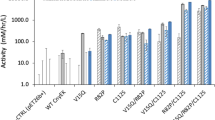Summary
Although aspartate transcarbamylase (ATCase) is an independent, monofunctional enzyme in Escherichia coli, mammalian ATCase is one of the globular enzymatic domains of the multifunctional CAD protein. We subcloned fragments of the hamster CAD cDNA and assayed polypeptide products expressed in E. coli for ATCase activity in order to isolate a stretch of cDNA which encodes only the ATCase domain. Three such expression constructs contain fragments of hamster CAD cDNA similar in length to the gene encoding the E. coli ATCase catalytic subunit (pyrB). These constructs yield stable proteins with ATCase activity, ascertained by both in vivo and in vitro assays; the clones also possess sequence homology with the pyrB gene at both the 5′ and 3′ ends. The clone producing the most active ATCase contains cDNA which is analogous to the entire pyrB gene, plus a small amount of CAD sequence upstream of this region. Because these constructs produce independently folded, active ATCase from a piece of cDNA the size of the E. coli pyrB gene, they open the door for the in-depth investigation of the isolated mammalian enzyme domain utilizing recombinant DNA technology. This approach is potentially useful for the analysis of domains of other multifunctional proteins.
Similar content being viewed by others
Abbreviations
- (EC 2.1.3.2):
-
ATCase, aspartate transcarbamylase
- CAD:
-
the trifunctional protein catalyzing the first three steps of pyrimidine biosynthesis in higher eukaryotes
- (EC 6.3.5.5):
-
CPSaseII, glutamine-dependent carbamylphosphate synthetase II
- (EC 3.5.2.3):
-
DHOase, dihydroorotase
- IPTG:
-
isopropyl-β-d-thiogalactopyranoside
References
Bartlett JA, Gaillard RK Jr, Joklik WK (1986) Sequencing of supercoiled plasmid DNA. Biotechniques 4:209–210
Bradford MM (1976) A rapid and sensitive method for the quantitation of microgram quantities of protein utilizing the principle of protein-dye binding. Anal Biochem 72:248–254
Chamberlain JP (1979) Fluorographic detection of radioactivity in polyacrylamide gels with the water-soluble fluor, sodium salicylate. Anal Biochem 98:132–135
Coleman PF, Suttle DP, Stark GR (1977) Purification from hamster cells of the multifunctional protein that initiates de novo synthesis of pyrimidine nucleotides. J Biol Chem 252:6379–6385
Davidson JN, Niswander LA (1983) Partial cDNA sequence to a hamster gene corrects defect in Escherichia coli pyrB mutant. Proc Natl Acad Sci USA 80:6897–6901
Davidson JN, Rumsby PC, Tamaren J (1981) Organization of a multifunctional protein in pyrimidine biosynthesis. J Biol Chem 256:5220–5225
Goldberg ME (1969) Tertiary structure of Escherichia coli β-d-galactosidase. J Mol Biol 46:441–446
Grayson DR, Evans DR (1983) The isolation and characterization of the aspartate transcarbamylase domain of the multifunctional protein, CAD. J Biol Chem 258:4123–4129
Hoover TA, Roof WD, Foltermann KF, O'Donovan GA, Bencini DA, Wild JR (1983) Nucleotide sequence of the structural gene (pyrB) that encodes the catalytic polypeptide of aspartate transcarbamoylase of Escherichia coli. Proc Natl Acad Sci USA 80:2462–2466
Janin J, Wodak SJ (1983) Structural domains in proteins and their role in the dynamics of protein function. Prog Biophys Mol Biol 42:21–78
Klotsky R-A, Schwartz I (1987) Measurement of cat expression from growth-rate-regulated promoters employing β-lactamase activity as an indicator of plasmid copy number. Gene 55:141–146
Konigsberg WH, Henderson L (1983) Amino acid sequence of the catalytic subunit of aspartate transcarbamoylase from Escherichia coli. Proc Natl Acad Sci USA 80:2467–2471
Laemmli UK (1970) Cleavage of structural proteins during the assembly of the head of bacteriophage T4. Nature 227:680–685
Maley JA, Davidson JN (1987) Identification of carbamyl phosphate synthetase coding region of the trifunctional CAD gene. Fed Proc 46:1948
Maniatis T, Fritsch EF, Sambrook J (1982) Molecular cloning: A laboratory manual. Cold Spring Harbor Laboratory, Cold Spring Harbor, New York, p 368
O'Callaghan CH, Morris A, Kirby SM, Shingler AH (1972) Novel method for detection of β-lactamases by using a chromogenic cephalosporin substrate. Antimicrob Agents Chemother 1:283–288
Patterson D, Carnright DV (1977) Biochemical genetic analysis of pyrimidine biosynthesis in mammalian cells: I. Isolation of a mutant defective in the early steps of de novo pyrimidine synthesis. Somatic Cell Genet 3:483–495
Rumsby PC, Campbell PC, Niswander LA, Davidson JN (1984) Organization of a multifunctional protein in pyrimidine biosynthesis. Biochem J 217:435–440
Sadler JR, Tecklenburg M (1981) Cloning and characterization of the natural lactose operator. Gene 13:13–23
Sadler JR, Tecklenburg M, Betz JL (1980) Plasmids containing many tandem copies of a synthetic lactose operator. Gene 8:279–300
Sancar A, Rupert CS (1978) Determination of plasmid molecular weights from ultraviolet sensitivities. Nature 272:471–472
Sancar A, Hack AM, Rupp WD (1979) Simple method for identification of plasmid-coded proteins. J Bacteriol 137:692–693
Sanger F, Nicklen S, Coulson AR (1977) DNA sequencing with chain-terminating inhibitors. Proc Natl Acad Sci USA 74:5463–5467
Schmincke-Ott E, Bisswanger H (1980) Introduction. In: Bisswanger H, Schmincke-Ott E (eds) Multifunctional proteins. Wiley, New York, pp 1–29
Shigesada K, Stark GR, Maley JA, Niswander LA, Davidson JN (1985) Construction of a cDNA to the hamster CAD gene and its application toward defining the domain for aspartate transcarbamylase. Mol Cell Biol 5:1735–1742
Wahl GM, Padgett RA, Stark GR (1979) Gene amplification causes overproduction of the first three enzymes of UMP synthesis in N-(phosphonacetyl)-L-aspartate resistant hamster cells. J Biol Chem 254:8679–8689
Weber K (1968) New structural model of E. coli aspartate transcarbamylase and the amino-acid sequence of the regulatory polypeptide chain. Nature 218:1116–1119
Wetlaufer DB (1981) Folding of protein fragments. Adv Protein Chem 34:61–92
Wiley DC, Lipscomb WN (1968) Crystallographic determination of symmetry of aspartate transcarbamylase. Nature 218:1119–1121
Author information
Authors and Affiliations
Additional information
Communicated by B.H. Judd
Rights and permissions
About this article
Cite this article
Maley, J.A., Davidson, J.N. The aspartate transcarbamylase domain of a mammalian multifunctional protein expressed as an independent enzyme in Escherichia coli . Mol Gen Genet 213, 278–284 (1988). https://doi.org/10.1007/BF00339592
Received:
Issue Date:
DOI: https://doi.org/10.1007/BF00339592




